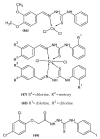New Potential Agents for Malignant Melanoma Treatment-Most Recent Studies 2020-2022
- PMID: 35682764
- PMCID: PMC9180979
- DOI: 10.3390/ijms23116084
New Potential Agents for Malignant Melanoma Treatment-Most Recent Studies 2020-2022
Abstract
Malignant melanoma (MM) is the most lethal skin cancer. Despite a 4% reduction in mortality over the past few years, an increasing number of new diagnosed cases appear each year. Long-term therapy and the development of resistance to the drugs used drive the search for more and more new agents with anti-melanoma activity. This review focuses on the most recent synthesized anti-melanoma agents from 2020-2022. For selected agents, apart from the analysis of biological activity, the structure-activity relationship (SAR) is also discussed. To the best of our knowledge, the following literature review delivers the latest achievements in the field of new anti-melanoma agents.
Keywords: BRAF kinase; MAPK pathway; PI3K–AKT pathway; anticancer activity; cancer; heterocyclic derivatives; ion channels; melanoma; targeted therapy.
Conflict of interest statement
The authors declare no conflict of interest.
Figures













Similar articles
-
Drug resistance of BRAF-mutant melanoma: Review of up-to-date mechanisms of action and promising targeted agents.Eur J Pharmacol. 2019 Nov 5;862:172621. doi: 10.1016/j.ejphar.2019.172621. Epub 2019 Aug 22. Eur J Pharmacol. 2019. PMID: 31446019 Review.
-
Antitumor activity of the selective pan-RAF inhibitor TAK-632 in BRAF inhibitor-resistant melanoma.Cancer Res. 2013 Dec 1;73(23):7043-55. doi: 10.1158/0008-5472.CAN-13-1825. Epub 2013 Oct 11. Cancer Res. 2013. PMID: 24121489
-
Developments in the Space of New MAPK Pathway Inhibitors for BRAF-Mutant Melanoma.Clin Cancer Res. 2019 Oct 1;25(19):5735-5742. doi: 10.1158/1078-0432.CCR-18-0836. Epub 2019 Apr 16. Clin Cancer Res. 2019. PMID: 30992297 Free PMC article. Review.
-
Mechanisms and strategies to overcome resistance to molecularly targeted therapy for melanoma.Cancer. 2017 Jun 1;123(S11):2118-2129. doi: 10.1002/cncr.30435. Cancer. 2017. PMID: 28543695 Review.
-
Cutaneous manifestations of vemurafenib therapy for metastatic melanoma.J Drugs Dermatol. 2015 May;14(5):509-10. J Drugs Dermatol. 2015. PMID: 25942671
Cited by
-
Terminal Phenoxy Group as a Privileged Moiety of the Drug Scaffold-A Short Review of Most Recent Studies 2013-2022.Int J Mol Sci. 2022 Aug 9;23(16):8874. doi: 10.3390/ijms23168874. Int J Mol Sci. 2022. PMID: 36012142 Free PMC article. Review.
-
Current advance of nanotechnology in diagnosis and treatment for malignant tumors.Signal Transduct Target Ther. 2024 Aug 12;9(1):200. doi: 10.1038/s41392-024-01889-y. Signal Transduct Target Ther. 2024. PMID: 39128942 Free PMC article. Review.
-
Cytotoxic, Antibacterial, and Antioxidant Activities of the Leaf Extract of Sinningia bullata.Plants (Basel). 2023 Feb 14;12(4):859. doi: 10.3390/plants12040859. Plants (Basel). 2023. PMID: 36840206 Free PMC article.
-
Ursolic acid interaction with transcription factors BRAF, V600E, and V600K: a computational approach towards new potential melanoma treatments.J Mol Model. 2024 Oct 10;30(11):373. doi: 10.1007/s00894-024-06165-y. J Mol Model. 2024. PMID: 39387972
-
Autophagy in BRAF-mutant cutaneous melanoma: recent advances and therapeutic perspective.Cell Death Discov. 2023 Jun 29;9(1):202. doi: 10.1038/s41420-023-01496-w. Cell Death Discov. 2023. PMID: 37386023 Free PMC article. Review.
References
-
- Matthews N.H., Li W.-Q., Qureshi A.A., Weinstock M.A., Cho E. Epidemiology of Melanoma. In: Ward W.H., Farma J.M., editors. Cutaneous Melanoma: Etiology and Therapy. Codon Publications; Brisbane, Australia: 2017. - PubMed
-
- Melanoma Skin Cancer Statistics [(accessed on 22 April 2022)]. Available online: https://www.cancer.org/cancer/melanoma-skin-cancer/about/key-statistics.....
-
- Heistein J.B., Acharya U. StatPearls. StatPearls Publishing; Treasure Island, FL, USA: 2022. Malignant Melanoma. - PubMed
Publication types
MeSH terms
Substances
LinkOut - more resources
Full Text Sources
Medical
Research Materials
Miscellaneous

